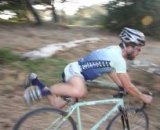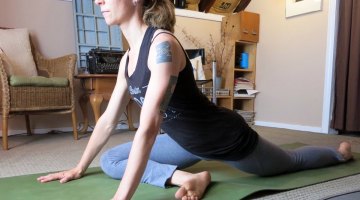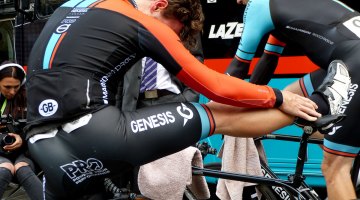It’s that time of year when cyclocross racers are pulling their bikes out of basements and garages, getting ready to do some drills. However, before you jump into the season and hit your saddle the wrong way, you might want to consider starting a stretching regimen before practicing remounts and dismounts. Contributing author David Perez has got some easy stretches to make sure you don’t suffer any setbacks before the racing has even begun. (This article was originally published in our premier Issue 1.)
The start of the cyclocross season always brings renewed energy to any rider. Many of you have already been racing the road or mountain bike circuits while others are coming off of other sports such as triathlons. Jumping back onto the ’cross bike brings into play a whole new set of mechanics that we must once again master. Mounts, dismounts, barriers and adverse weather conditions are common components of cyclocross and can lead to some very unique cycling injuries. In these articles, I will provide you with treatments and preventative measures for injuries typically seen in this sport. For some of you this material will build on existing knowledge from previous injuries. For the rest of you, if you implement some of the suggestions outlined here, it may be the difference between a pain-free season and one ruined by dealing with difficult injuries.
So, in this christening article we will address one of the more common (and painfully obvious) choices: the groin strain. The sport of cyclocross can have a high rate of groin injury. Think about the unique aspects of ’cross and you can see where the potential stressors are. When you pull or strain your groin you have overstretched and caused small (micro) tears in the muscles that surround your groin. These are referred to as the adductor muscles and they span from the inner pelvis (groin) down through the inner parts of your thighs and attach primarily at the knee. They are concerned with pulling or maintaining your legs toward the midline of your body and also act to help stabilize the hip joint.
In cyclocross, these muscles come into play when you mount and dismount your bike. Swinging your leg around the saddle is a potential stressor to the area and can cause overstretching and strain to the groin muscles. This is especially true early in the season when our technique is not as refined as it should be. We jump a little higher to avoid hitting our privates and push off a little harder with the back foot to gain extra speed, and our body is not accustomed to these explosive, awkward motions. It’s easy to see in this scenario how a groin strain can occur. An injury of this type can also be caused by running uphill barriers, abruptly changing direction while running, or managing a change in terrain.
Your previous injury history, athletic background, and the amount of cross training you do all play a role in deciding which of the above mechanisms may affect you (and your groin). The important part of all this is to realize that when you have a sore groin you should take steps to prevent this acute condition from becoming chronic. Anyone who has had a serious groin pull can tell you how debilitating this injury can be. Much like back pain, you can feel it during nearly all motions.
Groin strains are like any other muscle strain and are graded according to the severity of the injury.
- A grade I typically presents with mild soreness and no real strength loss or swelling. Riders are usually able to continue riding and running. This is a result of micro tears in the fibers of your groin muscle(s).
- A grade II is a partial tear of the affected muscle(s) and can present with moderate soreness and muscle weakness. A limitation of more strenuous activities such as running hills and mounting your bike is common.
- A grade III is marked by significant bruising, swelling and pain with nearly all motions. A moderate amount of muscle weakness is also present. The cause of this type of strain is the result of applying a significant force through the muscle which causes a complete rupture from the bone. If this occurs, stop any physical activity and consult your primary care physician.
My Groin Hurts, Now What?
- Warm It Up: Muscles respond best to stretching when tissues are warm. Performing an active warm-up on a stationary trainer or riding the flats prior to a race or ride will elevate tissue temperature and stimulate blood flow, both of which will allow muscle tissue to become more elastic. Applying a hot pack prior to stretching or riding is also an option, especially when the weather turns cold or for moderate to severe groin pulls.
- Stretching: Gentle stretching of the area is considered necessary to maintain elasticity thereby regulating any muscle imbalances that can occur. The best way to stretch muscle tissue is gradually over time; avoid performing quick jerky stretches that can worsen your symptoms. Use pain and soreness as a guide. Always perform a prolonged stretch of moderate intensity (three repetitions of 30 seconds). See pictures on the following pages.
o Recent studies have shown a decrease in muscular strength and force production and possibly stability when the muscles are stretched greater than 20% of their resting length1. My suggestion: perform stretches of low to moderately low intensity prior to an event with the aim of working the involved muscle through its normal range of motion. Stretches of moderate intensity can be performed following a training ride or race.
o Due to the attachment of the involved muscles, keeping your leg straight while stretching will primarily target the long groin muscles, while keeping your knee bent will stretch the shorter groin muscles.
- Ice: If you experience a strain in your groin during riding or wake with a sore groin, apply ice to the area especially within the first 48 hours. Ice helps calm any inflammation and later stimulates blood flow, both of which are needed.
- Rest: Regardless of the severity of the strain, rest is indicated to allow the body time to heal. This is obvious, yet we all know how athletes dislike resting. In the end it will allow you to recover more quickly and may stave off future chronic groin strains.
- Meds: Anti-inflammatories can help calm down inflammation and subdue the pain but should not be relied upon or used instead of properly rehabilitating the injury. If your injury does not respond to the above steps and your physician approves, then medication may be a prudent option. Typically many athletes dislike taking any medications (myself included), but this becomes another part of the treatment if your condition does not improve.
- Physical Therapy: If symptoms do not alleviate within two weeks of the injury, it may be time to seek out a health care professional that is familiar with your sport. You may be on track for a chronic problem and injuries are most easily treated within the first few weeks. Groin strains, while common, can be a result of much more complicated circumstances such as muscle tightness, muscle imbalances and muscle weakness in your core, hips and pelvis. Symptoms of a groin strain can also mimic other conditions such as hernias and insidious low back pain; all the more reason to consult with a medical doctor and a physical therapist. Other options become available when you see a therapist such as: assessing any muscular imbalances, restoring back and pelvic alignment, ultrasound, and soft tissue massage which you may need to completely resolve this injury.
- Technique: Incorporating drills that specifically work on your technique can help prevent many injuries. In a complicated case, it’s difficult to determine if your form is causing your muscle imbalance and chronic groin injury or vice versa. Often, a coach or trainer is invaluable to help treat these injuries and to determine where your form deviates and has the potential to cause your injury. A coach working with a health care provider can also allow you to maintain some sort of riding/racing schedule by limiting certain activities such as sprinting out of the turns. You may not like it, but at least it will keep you riding.
Prevention! Prevention! Prevention!
The key to preventing any muscle strain is to perform an adequate warm-up. Because the muscles that make up your groin are involved in virtually all motions, especially in cyclocross, an adequate warm-up becomes paramount. In a perfect session or pre-race warm-up, you would have time to stretch and to ride and run part of the course, gradually increasing intensity every lap. Follow this up with some ice and light stretching following your ride or race. Later that day, stretch again.
If you feel any sort of groin strain during a ride or pre-race warm-up, stop, stretch and ride that section again. Pay attention to your technique and try to determine what it is that may have caused you strain. Is it running uphill? Mud, sand or up hill barriers? These are the keys to remember later so you can focus on this in your training. Simply writing it off as a fluke is the basis of a recurring injury.
Other Groin Concerns
- One very common cause of groin strains to those who ride road exclusively is simply running. The stress of having to carry your own body weight alone can cause an unusual stress to the area. Throw in all the cyclocross dressing (mud, sand, stairs, mounts, carrying the bike) and you can see how this would be enough to cause and become a chronic problem. As a preventative measure, some of you may need to increase your running time or mileage. Keep in mind that running promotes muscle breakdown and increases recovery time. During race season, you should already have one running day in your program that typically consists of hill repeats. Consider adding another running workout at lactate threshold (moderate intensity) for no longer than 15 minutes, emphasizing speed and maintaining your target heart rate instead of running uphill. This workout can be done as a separate session (with a warm up and cool down) or in place of a threshold interval that would normally be done on the bike. Also, incorporate simple strengthening exercises as part of your training. I will cover these exercises in detail in the next article. You should already have a stretching routine incorporated into your daily living; now just add the strengthening two to three times per week.
- Your bike fit may also be an issue and something that needs to be looked at. This is best left to your coach and therapist to help determine the best possible fit for you during and after your injury.
Summary
- Cyclocross has many unique aspects that can lead to a higher rate of groin injury. As a result, technique becomes especially important and should always be incorporated into your training.
- Prevention: Always perform an active warm-up of low intensity. Follow this with stretches of moderate intensity (three repetitions of 30 seconds) two to three times per day. Also make sure you remember to strengthen your hips, core and back at least two times per week.
- If you have a groin strain, the warm-up to any ride or race becomes central to recovery. Follow the prevention keys above; you can also use a hot pack prior to getting on the bike to loosen up the tissues. Following your ride, stretch again and use an ice pack. At home, continue stretching and applying an ice pack to calm down tissue irritation and swelling.
- Consider seeing a physical therapist if symptoms persist. Also have your coach watch your technique and the way you ride to help determine the source of irritation to your groin.
Take the time to implement some of these guidelines as they can help prevent injuries or reduce their number. If there’s an injury you may have just sustained or one you’ve been dealing with, let CXM know and I’ll try to cover it in the future articles.
Sitting Groin Stretch (Butterfly)
Sit with your knees bent and the soles of your feet touching each other. Make sure you keep your back straight, hold your ankles/feet and gently lean forward at the hip.
To obtain a greater stretch, gently press your knees down with your elbows (not shown).
Prone Groin Stretch (Frog Stretch)
This stretch is essentially the butterfly stretch (above) on your stomach. Again make sure you keep your back straight.
Standing Groin Stretch
Keep the leg of the side you wish to stretch straight, and gently lean onto the other leg until you feel a stretch. The picture shows stretching of the left side of the groin.
Make sure you keep your back straight.
Supine Groin Stretch
Lay on your back as shown in the picture. To assume this position, sit next to the wall either facing left or right. Then lie down and splay your legs onto the wall. Make sure you are up against the wall to help support your legs and lower back.
Let your legs fall out until you feel a stretch. Be careful with this particular position as it can provide a very high amount of muscle tension.
David Perez, PT, DPT, CSCS is a Doctor of Physical Therapy and co-owner of Peak Orthopedic Physical Therapy in Berkeley and Sunnyvale, California. He is a USA Cycling and USA Triathlon Certified Coach as well as an NSCA Certified Strength and Conditioning Specialist. He spends much of his own time recovering from injuries and helping athletes return to sport.
References:
1. Shrier, Ian. Does Stretching Improve Performance?: A Systematic and Critical Review of the Literature. Clin Sports Med. 2004; 14:267-273
Stretches should be performed for 30 seconds with at least three repetitions. After an active warm-up, perform these stretches with a low to moderate amount of intensity, focusing on stretching the muscle in its current range of motion. After you ride, stretch again but with a moderate amount of intensity.
































